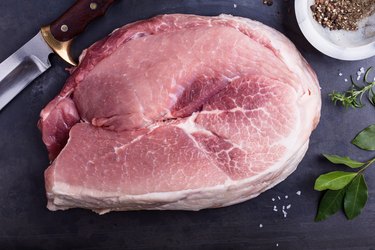
If you're looking for a flavorful cut of ham, the butt (rump) portion is an excellent choice. Also known as the ham butt end or the ham sirloin end, the tender cut comes from the top portion of the pig's leg, next to the loin. "Ready-to-cook" versions are raw and must be cooked before eating.
Tip
The USDA says the best way to cook a smoked or unsmoked ham butt portion is in the oven at 325 Fahrenheit. Allow 35 to 40 minutes per pound to roast a bone-in ham butt and makes sure the internal temperature reaches 145 F by the end of cooking. Leave the ham for three minutes before carving.
Video of the Day
The official USDA definition of "ham" is pork meat that has been cured. "Fresh ham" on the other hand, means the meat is in its natural, uncured state. Curing is the addition of salt, nitrates and nitrites, as well as sometimes sugar, seasonings and phosphates to preserve the pork and enhance its color and flavor.
Video of the Day
Hams may be smoked as well as cured, and they may be sold uncooked or cooked. It's important to read the label carefully to see whether a ham needs cooking to make it safe, as curing means that both ready-to-eat and raw versions are similarly pink in appearance.
Roasting Ready-to-Cook Ham
The USDA says the best way to cook a smoked ham butt portion — or an unsmoked one if that is your preference — is in the oven at 325 Fahrenheit. Allow 35 to 40 minutes per pound to roast a bone-in ham butt and makes sure the internal temperature reaches 145 F by the end of cooking. Leave the ham for three minutes before carving.
Adding a ham glaze will make a butt portion even more succulent and delicious. In a video for the National Pork Board website, chef José Mendin from Pubbelly Noodle Bar in Miami Beach recommends these ingredients to make the perfect ham glaze:
- Half a cup of water
- 8 ounces canned crushed pineapple in juice
- Half a cup of honey
- Half a cup of balsamic vinegar
- Two tablespoons unsalted butter
- Two tablespoons soy sauce
- Half a teaspoon chopped fresh thyme or quarter teaspoon dried thyme
- Half a teaspoon black pepper
To make the ham glaze from these ingredients you just need to bring them all to a boil over high heat, stirring often. Then reduce the heat to low and simmer, still stirring, until the liquid is reduced by about half, which should take seven to 10 minutes.
After cooling, this glaze is then ready to spread over your ham. Mendin recommends applying the first half of the glaze to scored skin after 30 minutes of cooking time. After a further 15 minutes, apply the rest of the glaze. You may need to tent the ham with aluminum foil to keep the keep glaze from scorching later in the cooking process.
Read more: How to Bake a Pre-Cooked Spiral-Sliced Ham
Nutritional Value of Ham Butt
The USDA advises that a three ounce fat-trimmed serving of ham butt (rump) has just 112 calories and 2.6 grams of fat. That means it is around 3 percent fat, which the American Heart Association says makes it a low-fat food.
The USDA also says three ounces of lean roast ham butt portion has plenty of B vitamins, including 6.3 milligrams of niacin, which is a nutrient important for energy. That's 31 percent of the Daily Value of niacin, according to the FDA.
The same size portion also offers 20.8 micrograms of selenium, according to the USDA. The Office of Dietary Supplements says the body needs selenium for a healthy reproductive system and thyroid gland, as well as to protect against infection and the damage caused by free radicals. The FDA says the Daily Value of selenium is 70 micrograms.
Ham can have a high sodium content (719 milligrams per three-ounce portion of lean ham butt, according to the USDA). And glazes can bump up the sugar content, too, depending on the ingredients.
Read more: What is the Healthiest Meat?